Volume 2 Issue 1 (2009) DOI:10.1349/PS1.1938-6060.A.324
Inside the Box: Accessing Self-Reflexive Television
Julie Levin Russo
After some high-profile staffing shakeups in the federal government in the fall of 2004, the Sacramento Bee ran a piece in the "Lifestyle" section comparing two recently promoted female officials: National Security Advisor and now former Secretary of State Condoleezza Rice and C.J. Cregg, the press secretary who had just stepped into the position of chief of staff on the political TV drama The West Wing.1 "Yes, we know that one of them is a real person and one of them isn't (and yes, we even know which is which)," professed author Rachel Leibrock, but the fact that such a disclaimer is necessary only underlines the article's premise: real and televisual zones are overlapping and corresponding rather than sharply discrete. Leibrock's article, although flippant, demonstrates that the cultural and symbolic borders between Condoleezza and C.J., between the world we inhabit and the world television characters inhabit, are both decisive and insubstantial. Leibrock gestures to a commonsense understanding of this topology—entertainment is contained within the four edges of the television screen, while the reality in which we participate exists outside it—but both television itself and television scholars have wrestled with the permeability of this threshold in practice. In this paper, I figure this boundary spatially, as the distinction between what's inside and outside of the television set, precisely to argue that the partition formed by the sides of the television box isn't as rigid as it might appear at first glance. While the inside/outside binary is a key axis in discourses of television, it is the inevitable failure of any attempt to stabilize it that is most enlightening, and analysis of television thus calls for a critical approach that can inhabit and express constitutive ambiguity and contradiction as fluently as does television itself.
Here, I review some of the literature that focuses specifically on self-reflexive television (or television as self-reflexive), a formal device that explicitly thematizes television and its border wars with the real. I ask how we, as critics, can take into account the rigorous recuperative ability of capitalism without simply slipping into a nostalgic privileging of stable distinctions between reality and entertainment, fact and fiction, outside and inside. In the midst of navigating this theoretical landscape, I apply its models to a close reading of a self-reflexive episode of The West Wing—"Access," which takes the form of a fictional documentary about C.J. Cregg and her role as press secretary—considering the textual, spectatorial, and economic operations in evidence. I hope to demonstrate how the key problematics I outline function in this specific case, but also to demonstrate an intellectual approach that leaves space for their complexities and contradictions. If I'm attempting to theorize television as a medium that holds contradictory spaces—the inside versus the outside (of the TV set, of the home, of the subject)—in distinction but simultaneously in imbrication, then writing about it, in consequence, must venture a parallel sort of paradox. There is a line to be walked between not discounting self-reflexivity's meaningful critical function and not being naively optimistic about the audience's ability to take up this critical position—the line, precisely, of there no longer being reliable lines at all. Ultimately, I argue that, while it is important to hold in view the complicity of self-reflexivity with consumer capitalism, the multiple subjectivities and realities of television's boundary crossings render this alliance far from simple or totalizing.
The West Wing, from which I take my artifact, is a drama series that ran for seven seasons on NBC (1999-2006). Palpably bred in the climate of the Clinton administration, it portrays the personal and political tribulations of Democratic President Bartlet (Martin Sheen) and his immediate staff. A paragon of what's colloquially termed "quality television," it is known demographically for its liberal, educated audience; formally for its high production values and luscious, cinematic visual style, extraordinary acting by an all-star ensemble cast, and fast-paced, cerebral dialogue; and narratively for "educationally" offering "a realistic, behind-the-scenes peek" into the inner workings of government.2 In other words, the program's "quality" status evokes a complex of overlapping and often conflicting interfaces with reality. Its supposed "superiority" inheres in its "realistic" depiction of politics, but the fact that it goes "behind-the-scenes" marks politics itself as already spectacular rather than real. By a circular logic, it is also considered realistic because of its superiority: the didactic value of presenting intelligent, nuanced explorations of timely civic debates gives it a patina of sober authenticity. At the same time, it promotes itself as a drama that deliberately explores nonfictional situations and personages through fabricated fictional counterparts; as such, its realism depends on the Hollywood reality effect of suture and seamlessness, rather than on the claim to a documentary-esque access to the real world. Its market appeal (especially since Bush replaced Clinton during the show's second season) lies as much in its construction of a left-wing fantasy government that diverges radically from actual U.S. politics as in any move to collapse reality into entertainment.
Kirsten Marthe Lentz asserts that when "quality television" became a recognizable category in the 1970s, it was particularly associated with feminism and the working-woman (paradigmatically, Mary Tyler Moore) as this figure became intertwined with "a self-reflexive critique of the medium itself."3 The function of critique is paramount here: this strategy was presented as "removed from and superior to 'normal' modes of televisual self-referentiality... a way of making television's banal mode of self-promotion into a new mode of critical reflexivity."4 While the specifics of this historical moment are, at the very least, submerged in The West Wing as a contemporary drama, reflexive critical operations surface with a vengeance in an atypical episode. Titled "Access" (March 31, 2004), this fifth season episode takes the form of a documentary: an eponymous PBS program profiling Press Secretary C.J. Cregg (Allison Janney). As the story goes, C.J., the most influential woman in the fictional Bartlet administration, has agreed to allow an acclaimed documentary team to follow her and film her activities on a typical workday. The final product is a fictional show with all the formal and narrative trappings of non-fiction, one that thematizes the precariousness of this very border via a powerful female professional, a choice Lentz suggests is not coincidental.
Self-reflexivity is often considered to be television's quintessential form of address, as it constantly refers back to its own formal, narrative, and institutional discourses. Certain programs or episodes, like "Access," adopt this orientation in more explicit and sustained ways. In his article "Prime-Time Fiction Theorizes the Docu-Real," John Caldwell surveys various instances of a specific self-reflexive genre into which "Access" fits: "episodes in entertainment programs that self-consciously showcase documentary units or modes as part of their narrative and plot and/or documentary looks and imaging as part of their mise-en-scène."5 He begins by acknowledging the textual and political complexity of this style, which simultaneously declares itself to be "programming 'stunts'—special episodes aimed at eliciting coverage and viewership... [and] also provide[s] an extensive set of critical-theoretical mediations on fundamental aspects and definitions of television, the televisual apparatus, and the television experience."6 In Caldwell's view, the latter is subsumed by the former, and ultimately "the docu-real serves the logic of corporate media conglomerates."7 Across multiple registers, the critical, deconstructive, postmodern mediations deployed by this form of self-reflexivity feed back into capitalist self-promotion.
In her discussion of the self-reflexive phenomenon of "inter-program referentiality," Mimi White similarly posits that this narrative device of fabricating crossovers between different programs is (virtually exclusively) "an obvious commercial-promotional strategy."8 She concludes that "television works to construct an all-encompassing 'world' containing everything—fact and fiction, information and entertainment, the real world and a simulacrum—the inclusivity of which is simultaneously nothing but an image of television itself."9 The passing reference to Baudrillard's theory of simulation is no coincidence: in both Caldwell and White's accounts, television appears increasingly like a simulacrum in the Baudrillardian sense, particularly in terms of the apparently inexorable circuit of capitalism. For Baudrillard, even capitalism is caught in the vicious cycle "of our time: the hysteria of production and reproduction of the real," such that "when [capital] wants to fight this catastrophic spiral by secreting one last glimmer of reality, on which to found one last glimmer of power, it only multiplies the signs and accelerates the play of simulation."10 The mediation of the real, in other words, is a calculated capitalist ploy—even if, in the grander scheme of things, even capitalism fails to stabilize any reality.
Caldwell's analysis of television's explicit version of this mediation is structured around the originary opposition of "the entertainment/drama versus news/reality worlds,"11 which in commonsense terms are purported to exist inside versus outside the television set, respectively. While he avers that "the segregation of these worlds is far from total," conceptually this "split" remains "a fundamental part of its viewer's consciousness."12 And, of course, the segregation of these two poles isn't value-neutral: the "real" is esteemed over the spectacular in a quintessentially modern tradition. The strategic genius of "docu-real" television, then, is that it appropriates the more authoritative representational regime: in "an electronic culture that awards public posture and mastery of the real... prime time flaunts its ability to step outside of narrative confines and break fictional constraints; it flaunts its ability to indulge in, mediate on, and deconstruct the real," with "works that perform the categories, guises, and styles of documentary and the real."13 Thus, as Baudrillard argues, "the hyperrealism of simulation is expressed everywhere by the real's striking resemblance to itself."14 This explanation is, I think, also subject to the aporias of Baudrillard's theory. Most crucially, it is only from a position of deep and abiding (modern) faith in the (former) integrity of the real and its (former) distinguishability from the realm of the imaginary or of representation that one could lament so intensely its total disintegration. It is only on the basis of a real conceptualized as having a stable definition and borders that one could posit that the real has now totally vanished into the simulacral circuit of late capitalism. A more nuanced perspective, which I hope to work through here, is that postmodernism is characterized, not by the death of one term (news, reality, representation) at the hands of the other (entertainment, spectacle, simulation), but by their increasingly multivalent interpenetration. This is a view that holds the operations in question—including those of critique and marketing mobilized by docu-real episodes in Caldwell's description—in parallel, resisting the a priori assumption that they are mutually exclusive and that the latter necessarily negates the former.
In "Watching Ourselves Watch Television," Jim Collins offers a comparable assessment, writing that "the dismissal of television as simulation depends upon the absence of a meta-discursive, ironic component in either images or their interpreters, yet the proliferation and recycling of the already represented produces a hyperconsciousness that makes a totalizing, seamless concept like Baudrillard's "hyperreal" difficult to maintain"15 In other words, television's "endemic" self-reflexivity is not as effortlessly absorbed by the regime of simulacra as TV critics often suggest. According to Collins, this view is haunted by "the Adorno/Horkheimer theorization of mass culture as bad object" and "undermined by its dependence on a mass-conspiracy scenario predicated on the hidden motive of the producer of the message and the lack of awareness of its receivers"16 Collins himself is, perhaps, naively sanguine about viewers" interpretive agency, about the transparent translation of television's "hyper-awareness of its own simulated, commodified nature"17 into a position of equal skepticism, "sophistication," and "distantiation" on the part of its audience. The attention of theorists like Caldwell and White to the ways that TV's (often smug and self-congratulatory) self-reflexivity serves the economic interests of the media industry—precisely by rewarding viewers with the pleasurable sensation of their own knowingness and media savvy—remains essential. Yet what Collins does contribute, in particular, is an exploration of the implications of this distinctly postmodern mode of media textuality for the subjectivity of spectatorship. He posits a viewer with the "ability to step inside and outside the television address at will" and "a notion of the television subject that is likewise both decentered and recentered, neither completely absorbed by all programming, nor entirely detached from it"18 A subject, that is, who—like the textual phenomena under discussion—can occupy contradictory positions simultaneously (for example, the position of critical distance and that of capitalist dupe, of "irony" and "involvement", who navigates the murky borderlands between (not definitively inside or outside) dichotomous terms.
Analyzing the formal operations of "Access" can highlight this subjective dimension of self-reflexive play. On the most literal level, "Access" appropriates the authoritative conventions of documentary to capitalize, as Caldwell argues, on the privileging of realness in modern discourse and hence, simultaneously (in Baudrillardian terms), exacerbating the disintegration of the real in favor of its simulation. The faux documentary genre has become a regular, even quintessential fixture of postmodern media, so this can hardly be considered an innovative or original gesture. What is particularly evident in "Access," however, is the equalization of varied registers of reality—a veritable smorgasbord that in itself already compromises any neat opposition of news and entertainment.
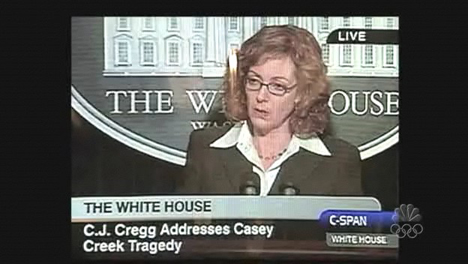
In Access (the diegetic PBS special), a coherent narrative with reliable truth claims is constructed by supplementing coverage of C.J.'s day with an assortment of stock footage—clips which viewers of "Access" the West Wing episode understand to be real archival record of past presidents, press secretaries, and press corps; home movies of actress Allison Janney's childhood; excerpts of C.J. on television (dating, within West Wing's timeline, from before the series pilot); and staged network news and C-SPAN segments relating to the episode's fictional crisis. The bad quality of the video marks all of these as suitably authentic. Also included are formal interviews with C.J. and with other regular characters on The West Wing, as well as with characters who appear only in this episode, and with made-up historical figures.

Produced for and by Access (as the narrator's voice-over explains), these interviews are carefully composed and lit, and they offer a manifest contrast to the roughshod video-journalistic aesthetic of the rest of the footage.
Appreciating the episode's virtuosic sham by parsing these diverse gradations of illusion is certainly an important aspect of its entertainment value for the critical viewer. But the fact that we can separate fact from fiction in the crudest sense doesn't negate the overall effect of a sort of continuum between them, a permeability of these distinct epistemological spaces. When C.J. and her imaginary fellow press secretaries comment on actual events in the history of the job while archival clips are shown, some of the realness of history rubs off on the characters via the educational value of the function they are providing. Appropriating Janney's home movies as C.J.'s highlights the blurred boundary between person and persona. And the verisimilitude of fake news implicates real news as media spectacle as well. In other words, the historical representation of press secretaries is filmed and presented on television just like the televisual versions who are seamlessly inserted into that lineage; the Dayton, Ohio where Janney grew up merges with the Dayton, Ohio where C.J. grew up; the world out there that the news ostensibly represents fades before the vividness of its appearance onscreen (whether real or fake). Just as in Lewis's account, the result is neither a perfect simulacrum nor a transparent gimmick, but a textual and spectatorial position wherein we retain commonsense epistemological distinctions between entertainment and reality while simultaneously experiencing and recognizing their imbrication, where we "think of a fiction program as both real and unreal... both external and internal to our world"19
In his article on reality TV, "The Meaning of Real Life," Justin Lewis elaborates on this constitutively ambiguous formation. He frames his argument with an ambivalent opposition similar to Caldwell's: while, on the one hand, "we now live in what John Corner refers to as a postdocumentary culture, one in which the traditional codes of documentary realism intermingle with genres based on celebrity and artifice,"20 on the other, "the distinction between authenticity and pretense, between reality and artifice, remains vital to the pleasure and politics of contemporary TV viewing"21 According to him, then, "television has become postmodern in form while remaining steadfastly modernist in its assumptions"22 In tracing this mixture, Lewis, like Caldwell, is interested in the ambivalent schism between the "real" that purportedly exists outside of television and the "entertainment" that is presented inside it, and in the ways in which the convergence between these two registers is continuously both repudiated and remanufactured across multiple, overlapping epistemological fields. Again, ideologically-inflected value judgments are also in play: "in most audience studies, the ability to signify reality on television is generally seen as positive," despite (or because of) the fact that "many viewers retain a high degree of skepticism about the authenticity of factual entertainment programs"23 Rather than ultimately collapsing both these positions into their functional economic benefits for the media industries, however, Lewis arrives at a view of the televisual "real" that retains the sort of suspended contradiction(s) that I'm envisioning. Also arguing explicitly against Baudrillard's vision of an "exterior world" entirely "ingest[ed]" by television, he maintains that "we can accept the veracity of two distinct realities: the one we live in and the mediascape"24 The fact that "these two worlds are juxtaposed so routinely that they seem to be two aspects of a single epistemological category ['reality']"25—that "it is difficult to consciously draw a line between the logic of the mediascape and the way we make sense of the unmediated world"26—does not entail that any and all distinction between the two has been dissolved.
What emerges for Lewis, rather, is an awareness of what I would call the permeable boundary between "realities" that nonetheless remain provisionally separate in crucial but always contingent ways. The result of this permeability is, Lewis states, "a culture with the ability to move almost seamlessly in and out of different perceptual planes, to think of a fiction program as both real and unreal...both external and internal to our world" and viewing subjects who "inhabit a space in the grey area between these two epistemes [and] flit back and forth" between them.27 Here, movement, liminality, ambiguity become the key conceptual terms, displacing appropriation, totality, and fixed opposition, although Lewis's retention of a binary structure curbs this theoretical departure somewhat. I'dlike to carry this theoretical inflection, derived from these discussions of various genres of self-reflexive television, into an exploration of how it functions in "Access" particularly.
That is, such effects of formal provocations embrace the situated viewing subject as much as they do abstract realities. The vérité style of "Access" as a "day in the life" documentary eschews any sense of a contained, composed alternate universe, bounded within the television set and visible on/through the screen, in favor of an active integration of the spectator's presence into the TV text. This occurs via the materiality of the cameraperson and his camera that play a dynamic and unmistakable role in the episode. When the narrator tells the viewer "Access goes behind the podium, and we invite you to come with us," this invitation to come along into a restricted zone is not merely a figure of speech. The camera—always handheld, always moving—literally follows C.J.
as she runs through the hallways and enters and exits rooms.
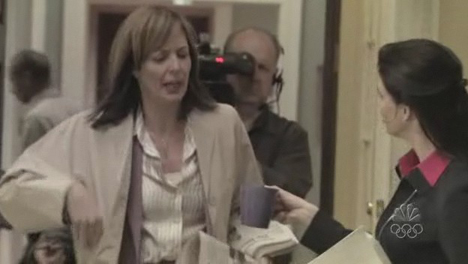
Badly composed shots call attention to the physicality of the cameraperson as he navigates spaces and stands among groups of bodies. This includes shots in which the film crew (apparently two cameramen and a sound guy) conspicuously appear, as if deliberately to emphasize the apparatus that spans the gap between "you" in your living room and the crew in the West Wing/The West Wing, between screen and lens. These are all recognizable cinema vérité devices for asserting video's authenticity, regularly appropriated by fictional and non-fictional television alike. But what "Access" accentuates particularly is the permeability of the aperture, its function for the spectator as a passage between spaces.
Take, for example, the episode's opening sequence. Following the faux PBS credits, we hear C.J.'s voice, and then see her image—strangely grey and blurry, and framed within a circle. The camera immediately pans out, and it's revealed that what we're looking at is a video viewfinder.
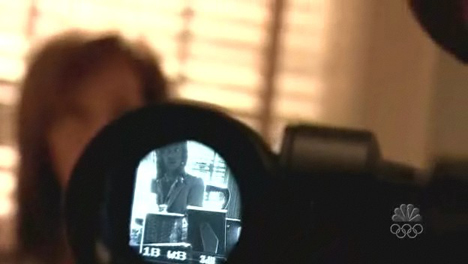
The shot skips and zooms around the room erratically, capturing the crew as they set up their equipment for the interview and C.J.'s conversation with one of them (who remains invisible behind the camera) about the "why" and "ground rules" of the project. Reality, in other words, is kaleidoscoped into fragments that refract each other: the "real" C.J. and her likeness in the ocular O of the viewfinder, the filming of Access (PBS special) and the filming of "Access" (episode of The West Wing), the eye that looks into the camera and our eye watching from home—all of these overlap and converge on the plane of the screen, as if we'ddonned a set of epistemological 3-D goggles. The introductory figure of the image inside the camera displays on television the conduit, the open tunnel through which the real travels from C.J.'s West Wing office/the set in L.A. to the box in front of us. There's a cheesy rewind noise, a black screen with the title, and only then do we see the "product":the interview itself, polished and flat. But when it comes to television, the holes in the screen are just as much its finished merchandise.
To puncture this plane even further, close to the end of the episode is a scene wherein C.J. says goodbye to the documentary crew as she leaves for the day. As she reaches outside of the frame, the shot pans down to reveal an arm extending from a body off-screen, shaking her hand. She then addresses the person filming—a salutation, that is, directly, intimately at us, who are occupying this position, our eye merged with the cameraman's eye.
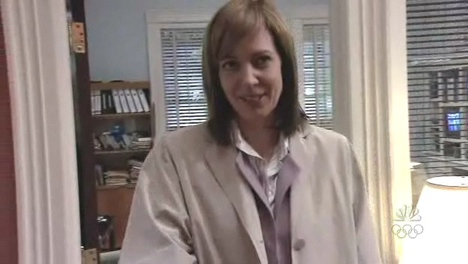
As C.J.'s arm extends into our space, we are likewise teleported into hers. This moment is overlaid with the narrator's concluding voice over: "The next day, most of the media coverage mentioned the administration's previous debacle at Casey Creek. Over the next nine months, one hundred charges were handed down in dozens of arrests..." He is providing a denouement for the episode's narrative, whose thematics here and throughout intersect with its formal devices. The plot involves a militia-FBI standoff that takes place in Shaw Island, Washington on the day of the Access filming. Within the diegesis, this crisis evokes the specter of an earlier (before the events of The West Wing's first season, which picked up midway through President Bartlet's first term) debacle at Casey Creek that ended badly for the Bartlet administration. In keeping with the oblique references to current events that are a signature of "quality" television's style, this storyline alludes, extra-diegetically, to the historical events at Ruby Ridge followed by Waco, Texas. The dramatic conflict at Casey Creek provides the context for a broader exploration of the "real" issue of contemporary news/media saturation, the role of the presidential press secretary in this milieu, and the role of the media in governance. As the narrator puts it, "Access became part of the modern media machine that witnessed a harrowing and historic day"—that is, there is an acknowledgment that this "PBS special" doesn't offer commentary from a position safely outside the fray, but participates in the construction of "history" and as fact and as affective experience. For the viewer, this engagement is simultaneously refracted by the episode's mockumentary status: while the episode undermines this distance formally, "Access" is ostensibly outside of "real" news, operating as entertainment and cultural critique.
"The media," and their participation in generating Shaw Island and Casey Creek as events, are materialized throughout the program as an aggressively ubiquitous technical apparatus. C.J.'s briefing room, part of the show's regular set, appears in uncharacteristically panoramic views, with the whole machinery of spectacle included.
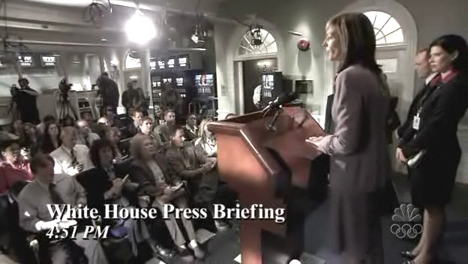
What is dramatized is not just the act of making television (a key aspect of C.J.'s job description) but the act of watching television—presented here as one of the primary channels of information flow into the West Wing. In one scene, the president is giving a press conference outside the building, while C.J. watches that press conference live on C-SPAN in her office.
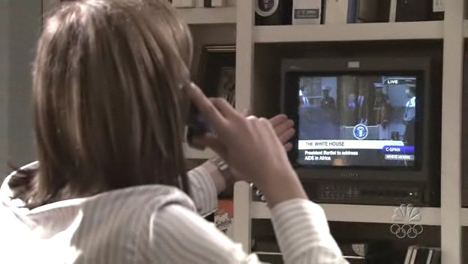
Shots of the two (the material and the televised events) are intercut, as if to illustrate most patently the sort of spatial collapse that television effects, wherein it brings the distinct spaces closer, even, than a stroll out the door might do. One crisis in the episode occurs when an FBI statement interrupts C.J.'s briefing, and the press secretary and press corps alike rush out of the room to witness it on TV—an activity that is not only filmed but filmed being filmed (in a quintessential self-reflexive circuit). Television is such an important character in Access/"Access" that there are also numerous shots that bypass the intermediary diegetic viewers to represent only other television screens—which, while certainly not conveying an impression of perforation, are a mind-bending mise en abyme that evoke an infinite progression of screens within screens.

This parallax view is only exacerbated by the additional degrees of separation in the case of a fictional program producing fictional versions of the news.
Such equivocal operations are not unique to "Access" and other explicit mobilizations of self-reflexivity. Both Lewis and White assert that this specific televisual phenomenon is a microcosm of a more extensive, diffuse formal principle, one that, according to Lewis "expresses the epistemological contradictions already involved in watching television,"28 and according to White, "is increasingly the stuff of which all television is comprised"29 It is not surprising, then, that since its early days, television has been both feared and revered as a medium that renders ostensibly stable boundaries between inside and outside penetrable and volatile—particularly the walls of the home. In his meditation on windows, Thomas Keenan quotes Hutchinson's 1946 primer, Here Is Television, Your Window to the World: "Television actually is a window looking out on the world... Television means the world in your home and in the homes of all the people in the world"30 Keenan duly notes the ambivalence manifested here about whether television is a "breach" that allows the gaze access to what is at a distance or a machine that enacts a sort of spatial collapse of this distant place into the place of the viewer—an ambivalence that amounts to an overall "confusion over inside and out"31 Lynn Spigel elaborates on the social context of this confusion (the introduction of television into the consumer household), arguing that "experts of the period [the 1950's] agreed that the modern home should blur distinctions between inside and outside spaces," and that "given its ability to merge private with public spaces, television was the ideal companion for these suburban homes"32 At the same time, this ambiguity was also the source of acute "anxieties," as "popular media expressed uncertainty about the distinction between real and electrical space"33 In early iterations of self-referential programming (such as The George Burns and Gracie Allen Show), wherein "television families were typically presented as "real families" who just happened to live their lives on TV," TV personalities "crossed the boundaries between fiction and reality on a weekly basis"34 In my view, such precarious frontiers are the result of a collision between entrenched binary ideologies and a historical context that dictated a passage between them, rather than reliably anchoring its mass medium to one side or the other.
This operation of mediation or transmission is highlighted by television's conventional association with "liveness" in theoretical discourse.35 More typically considered as a temporal mode, liveness also inextricably implies a distinct spatiality. If what's live is what's present (literally, or more often on television, metaphorically), this invokes an alignment in both the temporal and the spatial sense of the word: as the fetishization of instantaneous transmission engulfs any temporal gap, the spatial gap between the place of production and the place of reception is also collapsed. As in Here Is Television: what's there is also "in your home." Sam Weber understands this maneuver as a rupture as well as a fusion: "If television is both here and there at the same time, then... it can be neither fully there nor entirely here"36 Thus, the very unification of places that television effects is concurrently a breach in "everything that defines its identity with respect to place: events, bodies, subjects";37 television's presence is also a division which is then "covered" by a further sensation of presence. Thus, it not only dismantles boundaries, blends oppositions, inhabits between-ness, but simultaneously partitions spaces, fractures unities, and camouflages schisms. Moreover, "this unsettling tendency is also constantly being recuperated and reappropriated; and this allows television also to function as a bulwark of the established order. The more the medium tends to unsettle, the more powerfully it presents itself as the antidote to the disorder to which it contributes"38 That is, Weber, too, is concerned with the political implications of television's boundary-blurring disposition.
The attention in these theories to television that reflects and reflects on itself is apt, as windows are typically a prominent feature of The West Wing's visual language, in keeping with what Anne Friedberg identifies as a longstanding media heritage of windows figuring "the membrane between inside and outside."39 If, as Keenan suggests, the figure of the window, with its ambivalences and dangers, is a foundational metaphor for television in particular, this idiom is fittingly mobilized in "Access." The glass walls of the offices often frame Access's "behind the scenes" view into the West Wing's inner workings much as the edges of the television set do. The window is the mark of access itself, of the line of sight from one space into another that is partitioned from it. But the blinds are a reminder that the window's transparency isn't total, that it can screen as well as reveal, distort as well as transport.
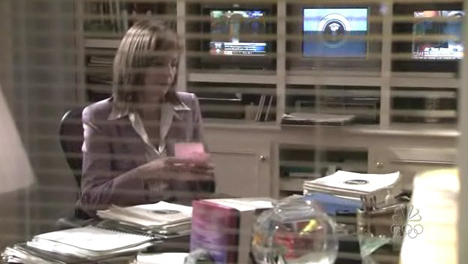
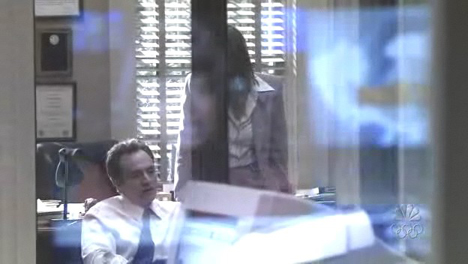
Windows are also ambiguous surfaces, prone to reflect back televisual images that are then overlaid on what's behind them, funhouse mirrors that superimpose the real (or, in this case, the simulation of it) and its mediation. If the response to narrative crisis is to run to a television screen, it is windows that signify television as crisis (the final shot is of/through the White House seal etched on glass, strangely diaphanous for an emblem of governmentality itself, and combining window and screen, transparency and reflection).

What's evident in "Access," then, is all the contradictions of self-reflexive television (and, perhaps, of television overall): it is not intended to be mistaken for anything but a self-contained fiction, a simulacrum, a gimmick; but, at the same time, it transgresses these categories, ruptures the screen, seeps out of the television set, allows the spectator to pass into it—in ways that are no less "real." Its reality, as Weber puts it, is "both here and there at the same time" and "neither fully there nor entirely here,"40 in an irresolvable suspension.
Both Lentz and Caldwell suggest that this self-conscious self-reflexivity, this deliberate enlistment of television's most engaging paradoxes, is primarily subsumed in its function as ingenious marketing ploy. Certainly, there is pleasure in being invited into television (or in inviting television in), in being the savvy viewer who appreciates the episode's formal and critical dexterity. Or, alternately, in being the savvy viewer who sees right through the gimmicks with disdain, like the reviewer at Television Without Pity, who writes "I am overwhelmed by the very authenticity of it all. In fact, it's so authentic I may fall authentically asleep right in the middle of it"41 But the economic consequences of this effect are no more easily contained than "Access"'s real-world references, which spill across the reality/entertainment border in unpredictable ways. If the objective in producing this (or any episode) of The West Wing (we might conjecture) is to make a marketable commodity, this is inextricable from the show's acclaim as "educational," as reflective of aspects of the "real" political landscape and reflecting on "real" events. While the appeal of the fictional documentary does not generally depend on it being mistaken for non-fiction, it is bound up with the play of these epistemologies, with the spectator's active investment in the flexibility of these distinctions. If this plasticity is recuperated by its capitalist instrumentality, then, this is precisely because the media industry depends on its own degrees of permeability. Marketing, that is, is only possible on the basis of a construction of and communication with the audience and its desires, and while the industrial technologies of ratings attempt to rationalize and quantify television viewing,42 the unruly engagement of subjectivity is not so easily reified. We watch because television addresses us, hails us as part of its world and attempts to infiltrate our material and subjective experience, not because its products are sealed in the hermetic zone of its producers. And it is often in self-reflexive moments that the interactivity of the medium is particularly apparent.
As one viewer puts it, what "Access" tells the audience is that "they know we're here"43 "They"—the show's shadowy producers—know that "we" watch PBS, that "we" are critical of the media, that "we" relate The West Wing to our understanding of the government and the news. With this episode's virtuosic deployment of the formal ambiguities of television's amalgamation of spaces, with its self-congratulatory criticism of the mediasphere in which it (of course) participates, they are talking to us—telling us that they know what we want, what we do as viewers; that spectatorship is about access, about our entry into their world and their world's entry into us. This species of self-reflexive metadiscourse about the constitution and work of audiences will only intensify as convergence—transformations in the technological, economic, and cultural organization of the industry to favor access and participation via multiple platforms—"requires media companies to rethink old assumptions about what it means to consume media"44 The endeavor of analyzing self-reflexivity is complicated by the fact that academic criticism can't stand reliably outside of television's own critical operations, since television itself has proven the market value of a similar mode of commentary. Although corporations can capitalize on and audiences can be seduced by this interconnectedness, because it is not a bounded space, it is never entirely reducible to these operations. There is always something in transmission, something happening in between that is not so easily characterized as inside or outside the control of consumerism or critique, the producer or the viewer, the televisual or the real.
About the Author
Julie Levin Russo is an acting assistant professor of new media in the Department of Art & Art History at Stanford University beginning January 2010. Her doctoral dissertation in the Department of Modern Culture & Media at Brown University is titled "Indiscrete Media: Television/Digital Convergence and Economies of Online Lesbian Fan Communities." Her other recent projects have included contributing to the editorial team of Transformative Works and Cultures, serving as a HASTAC (Humanities, Arts, Science and Technology Advanced Collaboratory) Scholar for 2008-2009, and co-editing a special Battlestar Galactica issue of the online journal FlowTV. She has presented on such topics as media convergence, online TV fandom, and cybersexuality at numerous conferences, and her work has been published in Camera Obscura and Cinema Journal, among others.
Endnotes
1 Rachel Leibrock, "C.J. Cregg versus Condoleezza Rice" (2004)
2 NBC.com, "About the Show," http://web.archive.org/web/20050415233504/www.nbc.com/The_West_Wing/about/index.html
3 Kirsten Marthe Lentz, "Quality versus Relevance," 47.
4 Ibid., 56-57.
5 John Caldwell, "Prime-Time Fiction Theorizes the Docu-Real," 259.
6 Ibid., 259-260.
7 Ibid., 288.
8 Mimi White, "Crossing Wavelengths," 52.
9 Ibid., 57.
10 Jean Baudrillard, "Simulacra and Simulations," 180.
11 Caldwell, 259.
12 Ibid., 259.
13 Ibid., 289/286.
14 Baudrillard, 180.
15 Jim Collins, "Watching Ourselves Watch Television," 268.
16 Ibid., 261/270.
17 Ibid., 270.
18 Ibid., 272/265.
19 Justin Lewis, "The Meaning of Real Life," 294.
20 Ibid., 288
21 Ibid., 288-289
22 Ibid., 288.
23 Ibid., 289-290.
24 Ibid., 289.
25 Ibid., 289.
26 Ibid., 299.
27 Ibid., 294/301.
28 Lewis, 289.
29 White, 60.
30 Thomas Keenan, "Windows: of Vulnerability," 130 [x-xi].
31 Ibid., 130.
32 Lynn Spigel, "The Suburban Home Companion," 212-213.
33 Ibid., 219.
34 Ibid., 224.
35 James Friedman, "Introduction," 200.
36 Samuel Weber, "Television: Set and Screen," 120.
37 Ibid. 117.
38 Ibid. 126.
39 Anne Friedberg, "The Virtual Window," 340.
40 Weber, 120.
41 Miss Alli, "In the Newzzzzz…" (2004).
42 Eileen Meehan, "Why We Don't Count: The Commodity Audience," n.p.
43 Emily Salzfass, personal communication, January 1, 2005.
44 Henry Jenkins, Convergence Culture, 18.
Bibliography
Alli, Miss. "In the Newzzzzz..." Television Without Pity (March 31, 2004). http://televisionwithoutpity.com/show/the_west_wing/access.php.
Baudrillard, Jean. "Simulacra and Simulations." In Selected Writings, edited by Mark Poster. Palo Alto, CA: Stanford University Press, 1988.
Caldwell, John. "Prime-Time Fiction Theorizes the Docu-Real." In Reality Squared: Televisual Discourse on the Real, edited by James Friedman. New York: Rutgers University Press, 2002.
Collins, Jim. "Watching Ourselves Watch Television." Cultural Studies Vol. 3, No. 3 (1989): 261-281. [full text: doi:10.1080/09502388900490191]
Friedberg, Anne. "The Virtual Window." In Rethinking Media Change: The Aesthetics of Transition, edited by David Thornburn and Henry Jenkins. Cambridge, MA: MIT Press, 2003.
Friedman, James. "Introduction." In Reality Squared: Televisual Discourse on the Real, edited by James Friedman. New York: Rutgers University Press, 2002.
Jenkins, Henry. Convergence Culture: Where Old and New Media Collide. New York: NYU Press, 2006.
Keenan, Thomas. "Windows: of Vulnerability." In The Phantom Public Sphere, edited by Bruce Robbins. Minneapolis: University of Minnesota Press, 1993.
Leibrock, Rachel. "C.J. Cregg versus Condoleezza Rice." Sacramento Bee (November 23, 2004). http://web.archive.org/web/20050313051748/http://www.sacbee.com/content/lifestyle/story/11540770p-12439739c.html.
Lentz, Kirsten Marthe. "Quality versus Relevance: Feminism, Race, and the Politics of the Sign in 1970s Television." Camera Obscura 43 (2000): 45-93. [full text: doi:10.1215/02705346-15-1_43-45]
Lewis, Justin. "The Meaning of Real Life." In Reality TV: Remaking Television Culture, edited by Susan Murray and Laurie Ouellette. New York: NYU Press, 2004.
Meehan, Eileen. "Why We Don't Count: The Commodity Audience." In Logics of Television, edited by Patricia Mellencamp. Indianapolis: Indiana University Press, 1990.
Spigel, Lynn. "The Suburban Home Companion: Television and the Neighborhood Ideal in Post-War America." In Feminist Television Criticism, A Reader, edited by Charlotte Brunsdon, Julie D'Acci, and Lynn Spigel. Oxford: Oxford University Press, 1997.
Weber, Samuel. "Television: Set and Screen." In Mass Mediauras: Form, Technics, Media. Palo Alto, CA: Stanford University Press, 1996.
White, Mimi. "Crossing Wavelengths: The Diegetic and Referential Imaginary of American Commercial Television." Cinema Journal Vol. 25, No. 2 (Winter 1986): 51-64. [full text: doi:10.2307/1225459]
